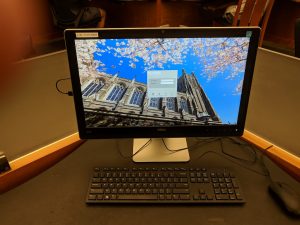Over the past year, you’ve probably noticed a change in the public computing environments in Duke University Libraries. Besides new patron-facing hardware, we’ve made even larger changes behind the scenes — the majority of our public computing “computers” have been converted to a Virtual Desktop Infrastructure (VDI).
The physical hardware that you sit down at looks a little different, with larger monitors and no “CPU tower”:
What isn’t apparent is that these “computers” actually have NO computational power at all! They’re essentially just a remote keyboard and monitor that connects to a VDI-server sitting in a data-center.
 The end-result is really that you sit down at what looks like a regular computer, and you have an experience that “feels” like a regular computer. The VDI-terminal and VDI-server work together to make that appear seamless.
The end-result is really that you sit down at what looks like a regular computer, and you have an experience that “feels” like a regular computer. The VDI-terminal and VDI-server work together to make that appear seamless.
All of the same software is installed on the new “computers” — really, virtual desktop connections back to the server — and we’ve purchased a fairly “beefy” VDI-server so that each terminal should feel very responsive and fast. The goal has been to provide as good an experience on VDI as you would get on “real” computers.
But there are also some great benefits …
Additional Security:
When a patron sits down at a terminal, they are given a new, clean installation of a standard Windows environment. When they’re done with their work, the system will automatically delete that now-unused virtual desktop session, and then create a brand-new one for the next patron. From a security standpoint, this means there is no “leakage” of any credentials from one user to another — passwords, website cookies, access tokens, etc. are all wiped clean when the user logs out.
Reduced Staff Effort:
It also offers some back-end efficiency for the Specialized Computing team. First off, since the VDI-terminal hardware is less complex (it’s not a full computer), the devices themselves have been seen to last 7 to 10 years (vs. 4 years for a standard PC). There have also been reports that they can take quite a beating and remain operational (and while I don’t want to jinx it, there are reports of them being fully submerged in water and, once dried out, being fully functional).
Beyond that, when we need to update the operating system or software, we make the change on one “golden image” and that image is copied to each new virtual desktop session. So despite having 50 or more public computing terminals, we don’t spend 50-times as much effort in maintaining them.
It is worth noting that we can also make these updates transparent to our patrons. After logging in, that VDI session will remain as-is until the person logs out — we will not reboot the system from under them. Once they logout, the system deletes the old, now-outdated image and replaces it with a new image. There is no downtime for the next user, they just automatically get the new image, and no one’s work gets disrupted by a reboot.
Flexibility:
We can, in fact, define multiple “golden images”, each with a different suite of software on it. And rather than having to individually update each machine or each image, the system understands common packages — if we update the OS, then all images referring to that OS automatically get updated. Again, this leads to a great reduction in staff effort needed to support these more-standardized environments.
We have deployed SAP and Envisionware images on VDI, as well as some more customized images (e.g. Divinity-specific software). For managers who don’t otherwise have access to SAP, please contact Core Services and we can get you set up to use the VDI-image with SAP installed.
Future Expansion:
We recently upgraded the storage system that is attached to the VDI-server, and with that, we are able to add even more VDI-terminals to our public computing environment. Over the next few months, we’ll be working with stakeholders to identify where those new systems might go.
As the original hardware is nearing it’s end-of-life, we will also be looking at a server upgrade near the end of this year. Of note: the server upgrade should provide an immediate “speed up” to all public computing terminals, without us having to touch any of those 50+ devices.



